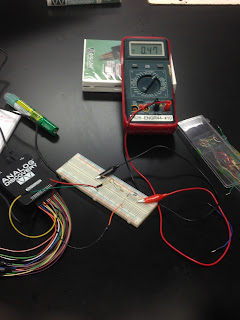PART 1: THEVENIN THEOREM
Thevenin’s theorem states that a linear two-terminal circuit can be replaced by an equivalent circuit consisting of a voltage source VTh in series witha resistor RTh , where VTh is the open-circuit voltage at the terminals and RTh is the input or equivalent resistance at the terminals when the independent sources are turned off.
The simplified circuit and formula based on the Thevenin Theorem
 |
The practical problem for thevenin theorem.
the everycircuit diagram for the previous practical problem
the professor's guidance by using Thevenin Thereom
Another Thevenin practical problme.
Part 2: Thevenin Lab
Purpose: This lab helps students grasp their understanding about Thevenin Theorem. We will set-up a familiar circuit, then create a Thevenin circuit with Vth and Rth, and independent load Rl. We will calculate and do experiment to verify our calculation.
Pre-lab: Calculation on the circuit
The solution for the Thevenin circuit: Rth = 7.4k Ohm, and Vth = 0.495V.
Procedure:
The set-up and the measured value of Vth = 0.47V. The percent difference with the calculated value: 4.25%
The measured values of the resistors, Vth, Vab (in red), and our calculation values (in green).
Table' columns: The value of the load resistor, the measured load resistor voltage, the calculated load resistor voltage, the percent difference between the measured voltage and the calculated one.
The graph power vs. load resistance. From the graph, we estimate that when load resistor is 8.02k Ohm the power is maximum.
Shortly, we observe the effectiveness of the Thevenin Theorem in analyzing the circuit with different load. In addition, in the end, we get the power vs. load resistance, which have non-linear relation. The maximum power is gained when the load resistor is 8.02k Ohm.
Part 3: Norton Theorem
Norton Theorem is similar to the Thevenin Theorem, expect we have to find the In of the simplified circuit instead of the Vth. Vth equals to the open circuit voltage, while In equals to the short circuit curent.
The practical for the Norton Theorem
Summary:
Today we learn about two more circuit analyzing techniques: Thevenin theorem and Norton theorem. These theorems is sharply effective in simplified the circuit and use this simplified circuit to calculate with different load resistors. We also do the Thevenin theorem lab to verify the theory and take a little further step to measure the power and observe the relation between the power and the load resistance.











No comments:
Post a Comment